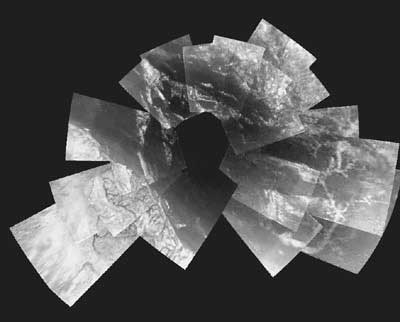






The Sight and Sounds of a Distant Moon:
Huygens Lands on Titan
By Steve Bartlett
The Huygens photos are being relayed to Earth by the Cassini spacecraft, now in orbit around Saturn. They will provide Earthbound scientists with a wealth of information for years to come. This is the most distant planetary surface to be studied by mankind.
 |
| This picture is a composit of 30 images from ESA's Huygens probe. They were taken from a altitude arying from 13 kilometers down to 8 kilometers when the probe was descending towards its landing site. The images have a resolution of about 20 meters per pixel and cover an area extending out to 30 kilometers. Photo credit: ESA/NASA/University of Arizona. |
The European-built Huygens spacecraft successfully landed on the Saturnian moon Titan on January 14, sending back spectacular views of its cold, methane-wet surface. The images showed terrain looking like streambeds, rocky shorelines, and dark, sandy beaches on the distant world.
The craft was carried on its seven-year journey to Saturn aboard NASA’s Cassini spacecraft and sent on its way to Titan in late December. It plunged into the moon ‘s thick atmosphere and survived a fiery entry at over 13,000 miles per hour before its heat shield and parachutes slowed it for a safe landing. On its way down, Huygens onboard cameras took over 350 photos of numerous features.
The spacecraft touched down on ground having a thin, brittle surface layer covering a soft, mushy subsurface. One scientist likened the Titanian ground to crème brûlée. Huygens continued to transmit data for over two hours after touchdown, sending back atmospheric measurements and sound recordings of a howling wind.
Because Saturn orbits over nine times as far from the Sun as Earth, it receives less than 1/90 the intensity of sunlight as Earth. This renders Titan‘s surface a chilly 293 degrees below zero Fahrenheit, so the rocks and sand pictured in the Huygens photos are believed to be made up of ice, and the streams and shore filled with liquid methane (also known as natural gas.) The moon’s atmosphere consists of nitrogen, methane, and gases similar to smog and is believed to be similar to the atmosphere of the early Earth.
The probe is named after Dutch astronomer Christian Huygens, who discovered Titan in 1655. It was built and operated by the European Space Agency. The Cassini spacecraft is operated by the NASA Jet Propulsion Laboratory in Pasadena and is the culmination of over twenty years of effort. It was launched aboard a Titan IV rocket from Cape Canaveral, Florida.
Web Links for Cassini-Huygens
You can listen to the sound recorded during during Huygens’ descent by the Huygens Atmospheric Structure Instrument (HASI), which includes an acoustic sensor, at http://www.esa.int/SPECIALS/Cassini-Huygens/SEM85Q71Y3E_0.html.
Find more information on the Cassini and Huygens missions at:
- http://saturn.jpl.nasa.gov/home/index.cfm
- http://saturn.jpl.nasa.gov/spacecraft/instruments-huygens.cfm
- http://www.esa.int/SPECIALS/Cassini-Huygens/
- http://www.nasa.gov/mission_pages/cassini/main/
Copyright © 1998-2005 Organization for the Advancement of Space Industrialization and Settlement. All Rights Reserved.